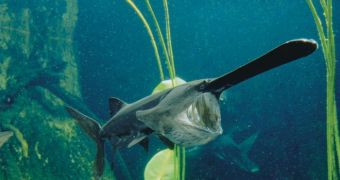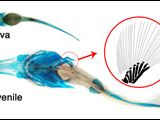Paddlefish (Polyodon spathula) together with the sturgeons are the only survivors of a primitive group of fish which evolved earlier than 200 million years ago, before the emergence of the dinosaurs.
This primitivism puts them closer to a basal evolutionary knot. Indeed, now they have come with a specific pattern of gene activity common to the limbs of all four-limbed animals that eventually lead to our hands and feet, rather than to the fins of a bass.
"The finding tells researchers that limbs were a long time in the making. This is showing that complex structures have a history and they're assembled over time-they don't happen in one fell swoop," said evolutionary biologist Neil Shubin of the University of Chicago and The Field Museum in Chicago.
Polyodon and sturgeons are the most primitive ray finned fish, included in most current fish species (except sharks, rays, Latimeria and lungfish). About 415 million years ago, primitive bony fish split in the ray-finned fish and the lobe-finned fish (that latter evolved into lungfish and tetrapods, the land vertebrates which eventually led to mammals).
Being so primitive, Polyodon keeps some "lobey" traits inside the ray-finned group.
Shubin's team investigated a fleshy nub located at the base of each of Polyodon's rear fins, each containing a fanlike bone array corresponding to the leg bones of the tetrapods. The team focused on the Hox genes, implied in the embryonic development of all vertebrates. The Hox genes divide embryos into regions that will form a different body section, like the tail, belly or head, by activating different combinations of them.
"Tetrapods show one pattern of Hox activity during late limb development, as their digits are forming, but the modern ray-finned fish show a different pattern, which has left researchers wondering how tetrapods arrived at theirs," said co-author Marcus Davis, an evolutionary biologist.
But Polyodon's embryo displayed the same pattern of Hox activity like in tetrapod limb, thus modern ray-finned fish pattern is an innovation and the tetrapod pattern is more ancient.
"The result fits with our group's discovery last year of a half-fish, half-tetrapod fossil called Tiktaalik, which had a palmlike bone structure in its flipperlike limbs." said Shubin.
"The Hox finding explains how Tiktaalik produced its complicated limb structure, and shows that the jump to tetrapods was not so large. It takes us quite a big step forward in understanding the shift from fins to feet. " said vertebrate paleontologist Jennifer Clack of the University Museum of Zoology in Cambridge, England.

 14 DAY TRIAL //
14 DAY TRIAL // 
